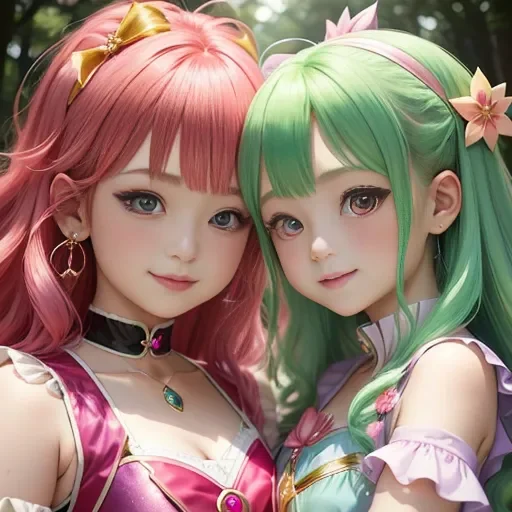The Magical Girl Evolution: From Glittering Heroes to Tragic Goddesses
Come visit our news page to see what new collections and lines we have gotten in. Anywhere from handmade to manufactured.!! Click Here!!!
♥
Come visit our news page to see what new collections and lines we have gotten in. Anywhere from handmade to manufactured.!! Click Here!!! ♥
What Is a Magical Girl?
“Magical girl” — or 魔法少女 (mahō shōjo) — is a term that instantly brings to mind sparkles, transformation sequences, friendship, and courage. At its heart, the magical girl genre celebrates empowerment: ordinary girls who are granted extraordinary powers, balancing their everyday lives with the responsibility of saving the world (and looking adorable while doing it!).
But behind the sparkles and pastel hues lies a fascinating evolution — one that stretches from early lighthearted stories to deeply emotional and even tragic tales.
The Origins of Magical Girls (1960s–1970s)
The story of magical girls begins in the 1960s, inspired by both Western witch sitcoms (like Bewitched) and Japan’s growing fascination with fantasy storytelling.
✨ 1962: Himitsu no Akko-chan introduced the first true magical girl. Akko’s mirror let her transform into anyone — a concept that would define the genre forever.
✨ 1966: Mahōtsukai Sally (Sally the Witch) became the first magical girl anime on television. Sally, a young witch princess from another world, tried to live a normal life on Earth while secretly using her magic to help others.
During this era, the tone was innocent, cheerful, and hopeful — reflecting a Japan in love with new technology, optimism, and youthful dreams.
The Sparkle Era: 1980s–1990s
By the 1980s, the magical girl formula had truly blossomed. Transformation wands, compact mirrors, ribbons, talking mascots, and heart-shaped charms became staples of the genre.
🌟 Creamy Mami (1983) and Minky Momo (1982) introduced the concept of dual identities — a normal girl transforming into an idol or an older version of herself. These shows weren’t just magical; they also connected to Japan’s idol culture, blending fantasy with real-world fame.
Then came the 1990s, when one name forever changed everything:
🌙 Sailor Moon (1991–1996)
Pretty Guardian Sailor Moon wasn’t just a story — it was a movement. It transformed magical girls into warriors of love and justice, fighting cosmic evil with friendship, moonlight, and matching outfits.
The series introduced the team dynamic, where each girl represented a planet, element, or color, uniting for a common cause. This formula shaped countless series after it — from Cardcaptor Sakura to Tokyo Mew Mew and beyond.
The Transformation of the Genre: 2000s–2010s
As time passed, magical girl anime began to mature along with its audience. What started as innocent empowerment stories grew into tales of sacrifice, identity, and existential struggle.
In the 2000s, shows like Magical Girl Lyrical Nanoha added serious combat and world-building, appealing to older fans. Others, like Pretty Cure, carried on the cheerful tradition for younger viewers.
But then came a series that changed everything — a dark mirror to all the hope and glitter that came before.
Puella Magi Madoka Magica — When Magic Turns to Despair
Released in 2011, Puella Magi Madoka Magica shocked audiences. It looked like a cute, pastel-colored magical girl series… until it wasn’t.
The story follows Madoka Kaname, a kind-hearted girl who meets a mysterious creature named Kyubey. He offers her a deal: she can make any wish she desires — in exchange for becoming a magical girl and fighting witches.
But what Madoka doesn’t know is that the contract hides a horrific truth.
Every magical girl’s “Soul Gem,” the source of her power, is also the source of her soul — and when it fills with despair, she transforms into the very witches she’s meant to destroy.
Throughout the series, friendships are broken, characters die, and time itself is rewritten as Homura Akemi tries again and again to save Madoka from her tragic fate.
The show’s ending is hauntingly beautiful: Madoka sacrifices her existence to erase the witches from history, becoming a concept of hope itself — a goddess who saves magical girls from despair.
It’s sad, philosophical, and devastating, exploring what happens when the cost of power is too high.
The Rise of Dark Magical Girl Stories
Following Madoka Magica, the genre opened up to deeper, more disturbing themes. Series like Yuki Yuna Is a Hero and Magical Girl Site explored trauma, death, and survival in ways previously unimaginable for the genre.
Even so, these darker shows still hold onto one thing: the core of hope that defines magical girls. No matter how grim things become, they fight on for love, justice, and a better world — a message that resonates with fans everywhere.
The Enduring Magic — And How It Inspires Kawaii Fashion
From transformation brooches and ribbon wands to moon pendants and pastel colors, the magical girl aesthetic has influenced kawaii fashion and accessories for decades.
At EeveeLuna, we celebrate that same energy — blending sweet fantasy and everyday magic through our jewelry and charms. Just like a magical girl’s transformation, a cute accessory can make you feel brave, confident, and radiant. 🌙💗
So whether you’re channeling Sailor Moon’s courage or Madoka’s compassion, remember — there’s a little bit of magic in all of us.
Final Thoughts
The magical girl genre is more than sparkles and cute costumes. It’s a reflection of our hopes, fears, and growth — from the innocent dreams of Sally the Witch to the cosmic heartbreak of Madoka Magica.
Even as it evolves, the message remains: kindness, courage, and love can change the world — and maybe even save it
.










